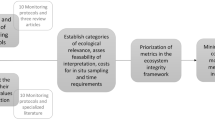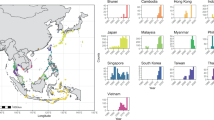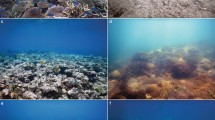Abstract
This study addresses the coupled themes of science and conservation by characterizing and evaluating the coral reefs around Yap, Federated States of Micronesia. Reef types, and the inherent environmental regimes they constitute, were found to be good predictors of distinct modern assemblages, with minimally overlapping species occurrences. Corals from inner and channel reefs were twice as large and assemblages were half as diverse compared with outer reefs, while food-fish were both larger and more diverse on outer and channel reefs compared with inner. While distinctions were predictable, the magnitude of ecological change along a gradient of inner, channel, to outer reefs was higher than expected, suggesting that human influences are quantifiable. Therefore, an evaluation process was conducted to determine the spatial trends in reef ‘condition’, defined within by ecological metrics. ‘Condition’ was highest for reefs associated with a priori defined high conservation value for varying reasons: successful fisheries management, critical habitat determination, and high resiliency potential. Regression analyses highlighted that a two-variable model which interactively incorporated proxies to fishing and pollution, as well as a proxy for hydrodynamic flushing potential, explained 40 % of the variance in ‘condition’. Collectively, the results are used to evaluate the current status of reef assemblages, and to point out future conservation priorities.







Similar content being viewed by others
References
Allen GR (2007) Reef fishes of Yap, Federated States of Micronesia. Technical report submitted to Yap Community Action Program. Yap State, FSM
Anderson M, Gorley R, Clarke K (2008) PERMANOVA + for PRIMER: guide to software and statistical methods. PRIMER-E, Plymouth, UK
Bak RPM, Meesters EH (1998) Coral population structure: the hidden information of colony size-frequency distributions. Mar Ecol Prog Ser 162:301–306
Balasubramanian V (1997) Statistical inference, Occam’s Razor, and statistical mechanics on the space of probability distributions. Neural Comput 9:349–368
Black K, Moran P, Burrage D et al (1995) Association of low-frequency currents and crown-of-thorn starfish outbreaks. Mar Ecol Prog Ser 125:185–194
Bohnsack JA, Bannerot SP (1986) A stationary visual census technique for quantitatively assessing community structure of coral reef fishes. National Oceanic and Atmospheric Administration Technical Report NMFS 41. Washington
Brander LM, Van Beukering P, Cesar HSJ (2007) The recreational value of coral reefs: a meta-analysis. Ecol Econ 63:209–218
Burgess SC, Kingsford MJ, Black KP (2007) Influence of tidal eddies and wind on the distribution of presettlement fishes around One Tree Island, Great Barrier Reef. Mar Ecol Prog Ser 341:233–242
Cesar HSJ, van Beukering P (2004) Economic valuation of the coral reefs of Hawai’i. Pac Sci 58:231–242
Cooper T, Gilmour J, Fabricius K (2009) Bioindicators of changes in water quality on coral reefs: review and recommendations for monitoring programmes. Coral Reefs 28:589–606
DeVantier L, De’Ath G, Turak E, Done T, Fabricius K (2006) Species richness and community structure of reef-building corals on the nearshore Great Barrier Reef. Coral Reefs 25:329–340
Donaldson T, Maragos J, Luckymis M et al (2006) Coral and fish surveys at Kosrae Island, July–August 2006, Federated States of Micronesia. Technical report submitted to The Nature Conservancy, Guam
Elmqvist T, Folke C, Nyström M et al (2003) Response diversity, ecosystem change, and resilience. Front Ecol Environ 1:488–494
Estes JA, Terborgh J, Brashares JS et al (2011) Trophic downgrading of planet earth. Science 333:301–306
Fabricius KE (2005) Effects of terrestrial runoff on the ecology of corals and coral reefs: review and synthesis. Mar Pollut Bull 50:125–146
Friedlander AM, Sandin SA, DeMartini EE, Sala E (2010) Spatial patterns of the structure of reef fish assemblages at a pristine atoll in the central Pacific. Mar Ecol Prog Ser 410:219–231
Graham T (1992) The application of traditional rights-based fishing systems to contemporary problems in fisheries management. A focus on the Pacific basin. Thesis, Oregon State University
Graham NAJ, Nash KL, Kool JT (2011) Coral reef recovery dynamics in a changing world: Coral Reefs (in press). doi:10.1007/s00338-010-0717-z
Gust N, Choat JH, McCormick MI (2001) Spatial variability in reef fish distribution, abundance, size and biomass: a multi-scale analysis. Mar Ecol Prog Ser 214:237–251
Heithaus MR, Frid A, Wirsing AJ et al (2008) Predicting ecological consequences of marine top predator declines. Trends Ecol Evol 23:202–210
Houk P, Starmer J (2007) Rapid ecological assessment for Yap, Ngulu, and Ulithi, Yap State, Federated States of Micronesia. Quantitative assessments of coral-reef assemblages and macroinvertebrate abundances. Technical report submitted to Yap Action Community Program, Yap, FSM
Houk P, Starmer J (2010) Constraints on the diversity and distribution of coral-reef assemblages in the volcanic Northern Mariana Islands. Coral Reefs 29:59–70
Houk P, van Woesik R (2010) Coral assemblages and reef growth in the Commonwealth of the Northern Mariana Islands (Western Pacific Ocean). Mar Ecol 31:318–329
Houk P, Didonato G, Iguel J et al (2005) Assessing the effects of non-point source pollution on American Samoa’s coral reef communities. Environ Mon Assess 107:11–27
Houk P, Musburger C, Wiles P (2010) Water quality and herbivory interactively drive coral-reef recovery patterns in American Samoa. PLoS ONE 5:e13913
Houk P, Rhodes K, Cuetos-Bueno J et al (2011) Commercial coral-reef fisheries across Micronesia: a need for improving management. Coral Reefs (in press). doi:10.1007/s00338-011-0826-3
Hughes TP, Graham NAJ, Jackson JBC et al (2010) Rising to the challenge of sustaining coral reef resilience. Trends Ecol Evolut 25:633–642
Jameson SC, Erdmann MV, Karr JR et al (2001) Charting a course toward diagnostic monitoring: a continuing review of coral reef attributes and a research strategy for creating coral reef indexes of biotic integrity. Bull Mar Sci 69:701–744
Johannes R (1978) Traditional marine conservation methods in Oceania and their demise. Ann Rev Ecol System 9:349–364
Kronen M, Tafileichig A (2008) Traditional rights and management of Yap’s coastal fisheries and the role of fisherwomen. SPC Women Fish Inform Bull 18:21–25
Lecchini D, Adjeroud M, Pratchett MS, Cadoret L, Galzin R (2003) Spatial structure of coral reef fish communities in the Ryuku Islands, southern Japan. Oceanol Acta 26:537–547
Mace AJ, Morgan SG (2006) Larval accumulation in the lee of a small headland: implications for the design of marine reserves. Mar Ecol Prog Ser 318:19–29
McClanahan T, Ateweberhan M, Omukoto MJ (2008) Long-term changes in coral colony size distributions on Kenyan reefs under different management regimes and across the 1998 bleaching event. Mar Biol 153:755–768
McClanahan TR, Graham NAJ, Muthiga NA et al (2011) Critical thresholds and tangible targets for ecosystem-based management of coral reef fisheries. Proc Natl Acad Sci (in press). doi:10.1073/pnas.1106861108
McCook LJ, Ayling T, Cappo M et al (2010) Adaptive management of the Great Barrier Reef: a globally significant demonstration of the benefits of networks of marine reserves. Proc Nat Acad Sci 107:18278–18285
Mumby PJ (2006) Connectivity of reef fish between mangroves and coral reefs: algorithms for the design of marine reserves at seascape scales. Biol Conserv 128:215–222
Nichols JD, Williams BK (2006) Monitoring for conservation. Trends Ecol Evol 21:668–673
Nyström M (2006) Redundancy and response diversity of functional groups: implications for the resilience of coral reefs. Ambio 35:30–35
Oliver L, Lehrter J, Fisher W (2011) Relating landscape development intensity to coral reef condition in the watersheds of St. Croix, US Virgin Islands. Mar Ecol Prog Ser 427:293–302
Pittman SJ, Brown KA (2011) Multi-Scale approach for predicting fish species distributions across coral reef seascapes. PLoS ONE 6:e20583
Roberts CM et al (2002) Marine biodiversity hotspots and conservation priorities for tropical reefs. Science 295:1280
Rodgers KS, Jokiel PL, Bird CE et al (2010) Quantifying the condition of Hawaiian coral reefs. Aquat Conserv 20:93–105
Rosenfeld JS (2002) Functional redundancy in ecology and conservation. Oikos 98:156–162
Sandin SA, Smith JE, DeMartini EE, Dinsdale EA, Donner SD, Friedlander AM, Konotchick T, Malay M, Maragos JE, Obura D (2008) Baselines and degradation of coral reefs in the northern Line Islands. PLoS ONE 3:e1548
Sheppard CRC (1982) Coral populations on reef slopes and their major controls. Mar Biol 7:83–115
Turak E, DeVantier L (2005) Reef-building corals and Coral Communities of Pohnpei, Federated States of Micronesia: rapid ecological assessment of biodiversity and status. Technical report submitted to The Nature Conservancy Micronesia Program, Guam
Veron JEN (2000) Corals of the world. Australian Institute of Marine Science, Townsville
Walmsley S, White A (2003) Influence of social, management and enforcement factors on the long-term ecological effects of marine sanctuaries. Environ Conserv 30:388–407
Wilson SK, Fisher R, Pratchett MS, Graham NAJ, Dulvy NK, Turner RA, Cakacaka A, Polunin NVC (2010) Habitat degradation and fishing effects on the size structure of coral reef fish communities. Ecol App 20:442–451
Wooldridge S, Done T, Berkelmans R et al (2005) Precursors for resilience in coral communities in a warming climate: a belief network approach. Mar Ecol Prog Ser 295:157–169
Yap Branch Statistics Office (2002) Yap State census report: 2000 FSM census of population and housing. Division of Statistics, Department of Economic Affairs, Colonia, Yap, Federated States of Micronesia
Yentsch CS, Yentsch CM, Cullen JJ et al (2002) Sunlight and water transparency: cornerstones in coral research. J Exp Mar Biol Ecol 268:171–183
Zvuloni A, van Woesik R, Loya Y (2010) Diversity partitioning of stony corals across multiple spatial scales around Zanzibar Island, Tanzania. Plos ONE 5:e9941
Acknowledgments
Financial support for this project provided by the National Oceanic and Atmospheric Administration, general coral reef conservation program, award NA05NMF4631049. The authors are grateful to the staff of the Yap Community Action Program and the numerous community representatives that assisted with logistics and fieldwork. Two anonymous reviewers and the topic editor provided constructive input that greatly benefitted our manuscript.
Author information
Authors and Affiliations
Corresponding author
Rights and permissions
About this article
Cite this article
Houk, P., Benavente, D. & Fread, V. Characterization and evaluation of coral reefs around Yap Proper, Federated States of Micronesia. Biodivers Conserv 21, 2045–2059 (2012). https://doi.org/10.1007/s10531-012-0296-0
Received:
Accepted:
Published:
Issue Date:
DOI: https://doi.org/10.1007/s10531-012-0296-0




